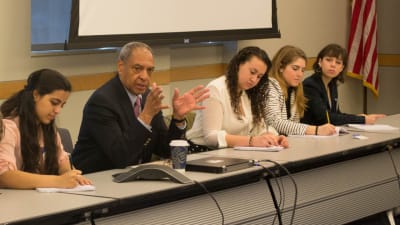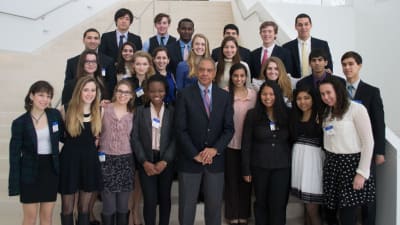Confronting Genocide: Spring 2013 Investigates the U.S. Role In Rwanda
In 1994, Rwanda lost nearly a million lives to a horrific genocide. The choices that Americans made during that genocide both haunt and inspire us. They also provide a compelling case study for SEGL students each semester.We began our week with the showing of the PBS Frontline documentary “Ghosts of Rwanda.” The film chronicles the genocide from warning signs to aftermath, placing special emphasis on the United States’ choice not to intervene. (More information about the documentary is available here.) A sober, stunned, and reflective conversation followed. And then, over the course of the week, our students met three people featured in the documentary.

On Saturday (the morning after students watched “Ghosts of Rwanda”) students met with last year’s SEGL Golden Mug winner Carl Wilkens, the only American to stay behind during the genocide. Carl’s insights are famous with every SEGL class, and his powerful and hopeful message resonated. One highlight: we often talk about whether or not something is our “responsibility,” but this can bog us down, Wilkens noted. Instead, we should turn the word around and consider our “ability to respond.” If we ask ourselves if we are able to respond, he said, it is often easier to see that we should.
On Wednesday we looked at the roots and effects of history’s most notorious genocide at the U.S. Holocaust Memorial Museum. Thanks to SEGL Board Member Dr. Jesse Nicholson, who is the Museum’s Director of Youth and Community Outreach, we entered the museum before it opened and received a special tour. For many students, it was the first time they had seen the shoes of Holocaust victims or stood in a boxcar that transported victims to camps; for others, it was an opportunity to reflect from a new perspective on something they had seen years ago. Russell Garnett, who trains Museum docents (among other responsibilities), led a thoughtful discussion that ended the visit.

We then traveled to the United Parcel Service’s DC headquarters (just two blocks from the SEGL residence) to meet with Laura Lane, UPS’s President of Global Public Affairs. Lane was effectively in charge of the U.S. Embassy in Rwanda during the genocide and was tasked with evacuating all Americans from the country when the genocide hit. She also knew Carl Wilkens, and the juxtaposition of the two accounts–Wilkens’s choice to stay and Lane’s decisions that helped keep all the other Americans safe from harm–was powerful and instructive. She discussed the many ways in which she helped Rwandans leave the country as “honorary Americans” as well as her regrets over not staying. Our 100 minutes with her flew by, but there is no doubt that her “one person can make a difference” message will stick for a long, long time.

On Friday we went to the United States Institute of Peace, just across from the State Department and near the Lincoln Memorial, to hear Ambassador George Moose. Moose was Assistant Secretary of State for Africa during the genocide and played an important part in organizing the U.S. government’s response. He is now Vice Chair of the USIP board and dedicated to helping the world learn the lessons of Rwanda. In response to impressive student questions, Moose explained the Institute’s work toward better recognizing the signs of genocide as well as his own role in 1994. Did he have any regrets from that time? He wished he had been more “obnoxious,” he said, referring to the complex bureaucratic decision making that hampered the government’s ability to respond. Students left the discussion with a greater understanding of the complex moral position that government leaders are in: can the U.S. be, as Madeline Albright has famously asked, “the world’s 9-1-1”?
Next week we up the ante and discuss arguably the world’s most intractable current international dispute: Israel and the Palestinians.









